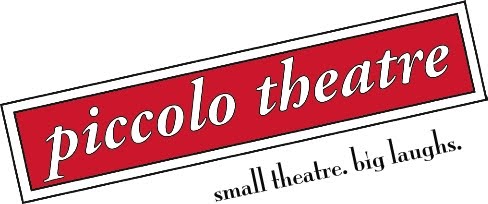You may not know that your favorite Chicagoland Piccolo Theatre named itself after The Piccolo Theatre of Milan, or, as the Milanese call it, il Piccolo. Back when our ensemble was forming, there was no question what our name would be. The Piccolo Ensemble did not simply hope to pattern ourselves after this venerable theatre. Our love of Commedia dell'Arte and our intellectual approach to the art form seemed to to be rooted in the same traditions as il Piccolo.
Our ensemble was lucky enough to see them perform Servant of Two Masters in 2005 at Chicago Shakespeare Theatre. (With the famous Ferruccio Soleri as Truffaldino!) And to top the evening off, we were able to meet the Teatro Piccolo actors at the post production party. What a night! Bella!
 |
| Ferruccio Soleri (il Piccolo), John and Jan Szostek (Piccolo Theatre) |
Piccolo was the first public resident theatre company in Italy. It was founded by Giorgio Strehler, Paolo Grassi and Nina Vichi, and inaugurated on 14th May 1947 with Gorky's L'albergo dei Poveri (The Hotel for the Poor).
 |
| Lady with Ermine- Leonardao da Vinci |
The small dimensions of the hall and of the stage pushed Grassi and Strehler, during the 1960s and the 70s, to ask for a new site for the theatre. During the 80s, Strehler repeatedly resigned from his Art Director position, hoping that his protest would move the cranes that for years remained uselessly parked nearby the Sforzesco Castle. The New Piccolo Theatre was inaugurated only in 1998, a year after Strehler's death. (Chicago's Piccolo Theatre considers is extremely lucky to have a home in the Evanston Arts Depot, and that artistic director John Szostek embraces our small theatre instead of resigning out of protest.)
Today il Piccolo is comprised of three theatre spaces:
 |
| Teatro Strehler (new site) |
 |
| Teatro Grassi (the historical base of Via Rovello) |
 |
| Teatro Studio (mostly for experimental works) |
Since its early beginnings the aim of il Piccolo has been to deliver drama to those categories of people (retirees, workers and students) who traditionally do not go to the theatre. In the Manifesto of the Piccolo we read:
This theatre (that is ours and yours), the first public City theatre in Italy, is promoted by the initiative of men of art and study, and is supported by the executive authority of those who are responsible for the city life. We do not believe that a theatre is what is left of mundane habits or an abstract tribute to culture. A theatre is the place where the community, meeting in order to contemplate and to re-live, reveals itself; it is the place where it tests a word, to accept it or to refuse it, and where that word, when accepted, becomes the centre of the city's activities and it suggests its rhythm.”
(translated from Italian by Claudia Zanella)
The repertoire of the Piccolo is both international and rooted into Italian tradition: Gorky, as previously mentioned, and Chekhov, but also Goldoni and Pirandello. Brecht has been performed since the late fifties and his theories on dramatic art deeply influenced Strehler. Other tremendously successful and popular works include: The Tempest by Shakespeare, The Thunderstorm by Strindberg but, most importantly, The Servant of Two Masters by Goldoni. This last piece was started to give Strehler some “rest” from his more philosophical works on the role of art, but proved itself to be the ideal play to provoke thoughts on dramatic art; it became very popular, and has been performed around the world for the last 70 years or so.
Thank you to Servant of Two Masters dramaturg, Claudia Zanella for the research and help with this post!











